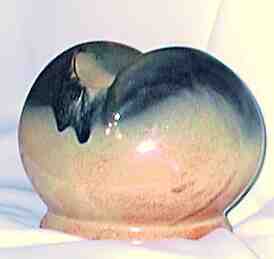©1999-2015
Wisconsin Pottery Association
P.O. Box 705
Madison WI 53701-0705
Pittsville Pottery
Pittsville Wisconsin
1931-1943
Additional information on the Pittsville Pottery, taken from the 1997 WPA Exhibit Brochure:

The above vase is done in a very similar glaze to Muncie's Peachskin.
The Pittsville Pottery was started by a Catholic priest named John Willitzer. Seeking industry for his local parish in Pittsville, Wisconsin, Willitzer, a German immigrant, sent local clay samples to Meissen, Germany for analysis of its suitability as a manufacturing clay body. A Dr. Julius Bidtel wrote back saying that it could be used for pottery. In 1931 the Wisconsin Ceramic Company was incorporated with the priest as president and with a capital of $75,000. A plant with a kiln was quickly built. The Depression, however, was not the ideal time to start a new business, and the firm failed in 1932. Willitzer paid $27,000 out of his own pocket to disgruntled stockholders, then started the business up again by himself with limited success. The new venture failed in 1936. In 1939 Father Willitzer gave James Wilkins and his son William a half interest in the pottery, which then operated until about 1943. James Wilkins had been a ceramicist at the Muncie Pottery of Muncie Indiana. Thus, some of the ware produced at Pittsville bears great similarity to that produced by Muncie, both in respect to shapes and glazes. Although Pittsville Pottery was not widely distributed, and certainly not long in production, local collectors estimate that as many as 50 different shapes may have been produced.
Nicol Knappen, WPA Member
WPA Editor's Note: WPA members Dave and Betty Knutzen are working with Ed Arnold on an oral history of Pittsville Pottery. Stay tuned for what promises to be the most definitive information to date, on the Pittsville Pottery!
Related Pages:








